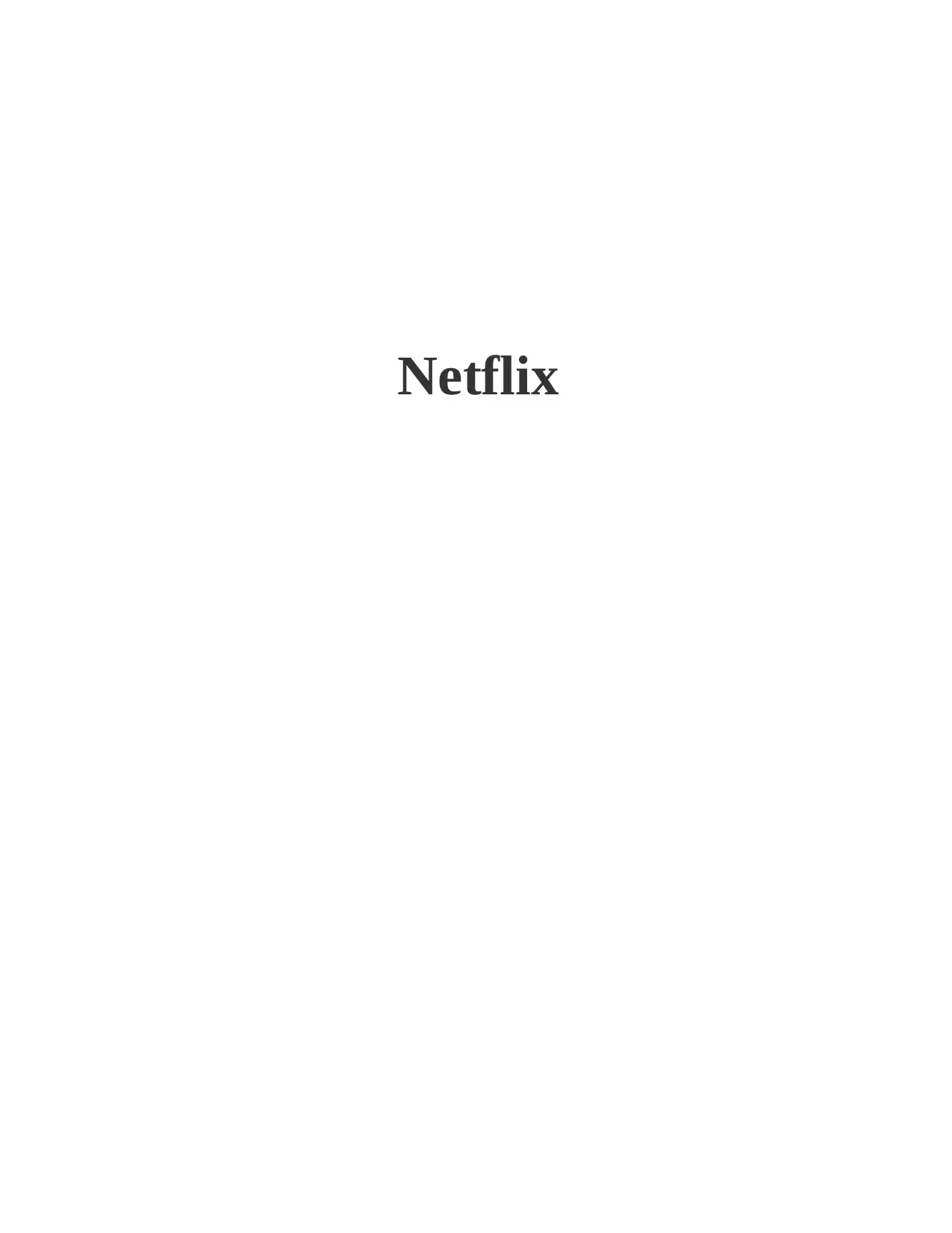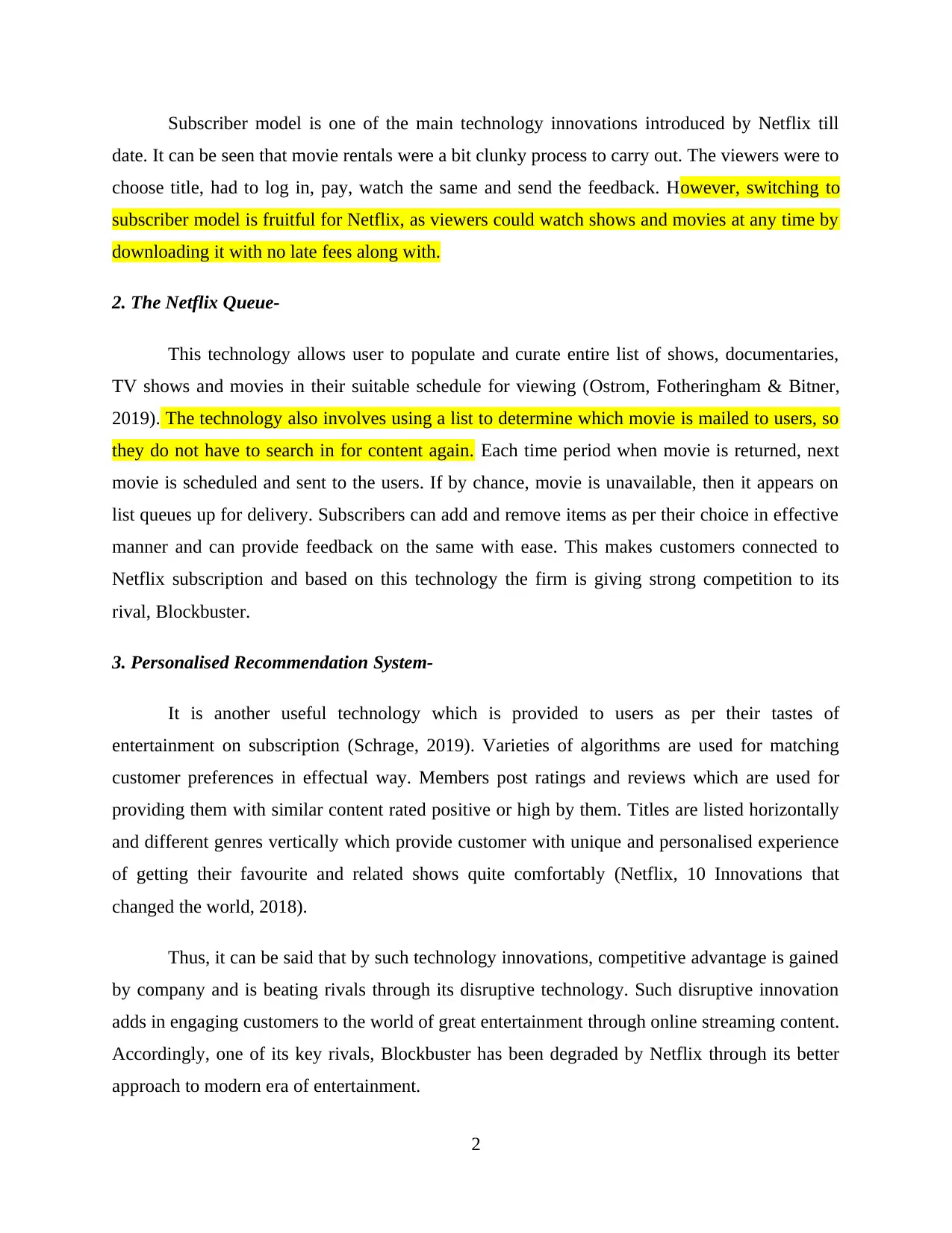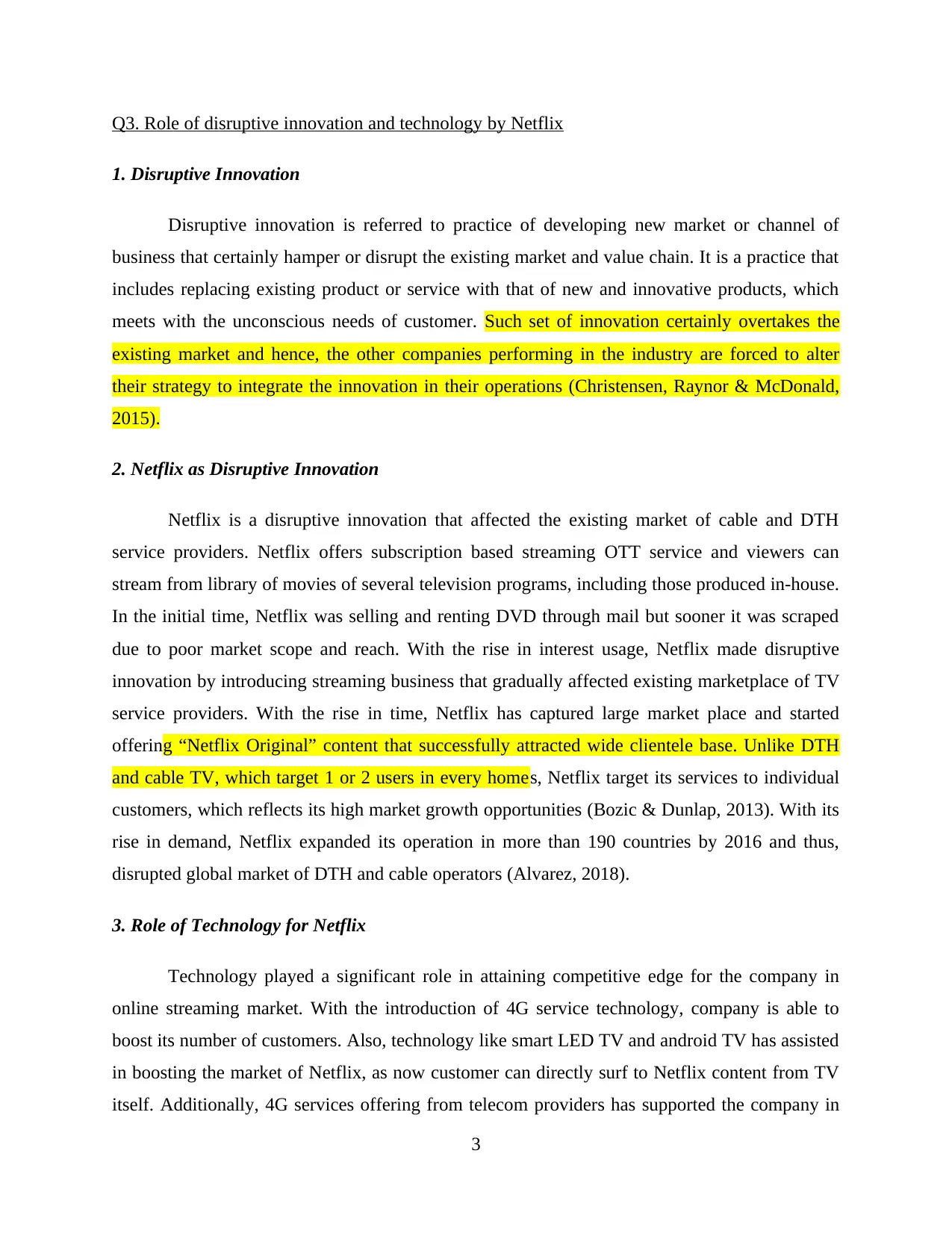Netflix's Competitive Advantage and Technological Innovations
VerifiedAdded on 2022/11/19
|7
|1548
|211
AI Summary
This article discusses Netflix's competitive advantage and how it gained success over Blockbuster. It also describes some technological innovations by Netflix to gain a competitive advantage. The role of disruptive innovation and technology by Netflix is also discussed.
Contribute Materials
Your contribution can guide someone’s learning journey. Share your
documents today.

Netflix
Secure Best Marks with AI Grader
Need help grading? Try our AI Grader for instant feedback on your assignments.

Table of Contents
Q1. Discussing Netflix competitive advantage and how gained success over Blockbuster........1
Q2. Describing some technological innovations by Netflix to gain competitive advantage.......1
Q3. Role of disruptive innovation and technology by Netflix.....................................................3
REFERENCES................................................................................................................................5
Q1. Discussing Netflix competitive advantage and how gained success over Blockbuster........1
Q2. Describing some technological innovations by Netflix to gain competitive advantage.......1
Q3. Role of disruptive innovation and technology by Netflix.....................................................3
REFERENCES................................................................................................................................5

Q1. Discussing Netflix competitive advantage and how gained success over Blockbuster
Netflix is one of the renowned online companies which is able to accomplish its desired
goals in the best manner possible. The value proposition of company is providing wide range of
online media services of highest quality in order to effectively engage customers. The value
proposition was “delivering entertainment”, thereby Netflix recognised that it needs to change its
skill set to cope with market shifts in a better manner. The bandwidths were expanded and as
global networks grew, Netflix was able to accomplish desired goals in an effective manner
(Keiningham et.al. 2019). It resulted in generation of many streaming purchase items’ content
providers for the firm, which lead to higher returns.
When company transformed its strategy from delivering physical media entertainment
(through DVD’s, tapes) to online content through internet streaming in 2011, better avenues
were accomplished. It can be traced out that Netflix has grown into highest subscribers in the
2018 reaching to 130 million which shows that customers are pretty much liking the band of
media and entertainment services. Due to higher customer base, the company’s revenue has
blown up by 57%.
International growth has reached to 70% and contribution origin has climbed to 15%
from being negative in 2017. This means that Netflix is able to grow faster than its rival
Blockbuster which does not rely on online streaming services. The company is engaged in
providing old and traditional services which has gone in vain (Teixeira & Piechota, 2019). This
shows that organisations lack behind Netflix having lower customer margin. It reflects the
leading position of Netflix in the media industry and the firm is entertaining its subscribers all
around the globe with its powerful content.
Q2. Technological innovations by Netflix to gain competitive advantage
Netflix is able to accomplish desired goals by engaging customers and gain competitive
advantage through technological innovation which are as follows-
1. Netflix, the Subscriber Model-
1
Netflix is one of the renowned online companies which is able to accomplish its desired
goals in the best manner possible. The value proposition of company is providing wide range of
online media services of highest quality in order to effectively engage customers. The value
proposition was “delivering entertainment”, thereby Netflix recognised that it needs to change its
skill set to cope with market shifts in a better manner. The bandwidths were expanded and as
global networks grew, Netflix was able to accomplish desired goals in an effective manner
(Keiningham et.al. 2019). It resulted in generation of many streaming purchase items’ content
providers for the firm, which lead to higher returns.
When company transformed its strategy from delivering physical media entertainment
(through DVD’s, tapes) to online content through internet streaming in 2011, better avenues
were accomplished. It can be traced out that Netflix has grown into highest subscribers in the
2018 reaching to 130 million which shows that customers are pretty much liking the band of
media and entertainment services. Due to higher customer base, the company’s revenue has
blown up by 57%.
International growth has reached to 70% and contribution origin has climbed to 15%
from being negative in 2017. This means that Netflix is able to grow faster than its rival
Blockbuster which does not rely on online streaming services. The company is engaged in
providing old and traditional services which has gone in vain (Teixeira & Piechota, 2019). This
shows that organisations lack behind Netflix having lower customer margin. It reflects the
leading position of Netflix in the media industry and the firm is entertaining its subscribers all
around the globe with its powerful content.
Q2. Technological innovations by Netflix to gain competitive advantage
Netflix is able to accomplish desired goals by engaging customers and gain competitive
advantage through technological innovation which are as follows-
1. Netflix, the Subscriber Model-
1

Subscriber model is one of the main technology innovations introduced by Netflix till
date. It can be seen that movie rentals were a bit clunky process to carry out. The viewers were to
choose title, had to log in, pay, watch the same and send the feedback. However, switching to
subscriber model is fruitful for Netflix, as viewers could watch shows and movies at any time by
downloading it with no late fees along with.
2. The Netflix Queue-
This technology allows user to populate and curate entire list of shows, documentaries,
TV shows and movies in their suitable schedule for viewing (Ostrom, Fotheringham & Bitner,
2019). The technology also involves using a list to determine which movie is mailed to users, so
they do not have to search in for content again. Each time period when movie is returned, next
movie is scheduled and sent to the users. If by chance, movie is unavailable, then it appears on
list queues up for delivery. Subscribers can add and remove items as per their choice in effective
manner and can provide feedback on the same with ease. This makes customers connected to
Netflix subscription and based on this technology the firm is giving strong competition to its
rival, Blockbuster.
3. Personalised Recommendation System-
It is another useful technology which is provided to users as per their tastes of
entertainment on subscription (Schrage, 2019). Varieties of algorithms are used for matching
customer preferences in effectual way. Members post ratings and reviews which are used for
providing them with similar content rated positive or high by them. Titles are listed horizontally
and different genres vertically which provide customer with unique and personalised experience
of getting their favourite and related shows quite comfortably (Netflix, 10 Innovations that
changed the world, 2018).
Thus, it can be said that by such technology innovations, competitive advantage is gained
by company and is beating rivals through its disruptive technology. Such disruptive innovation
adds in engaging customers to the world of great entertainment through online streaming content.
Accordingly, one of its key rivals, Blockbuster has been degraded by Netflix through its better
approach to modern era of entertainment.
2
date. It can be seen that movie rentals were a bit clunky process to carry out. The viewers were to
choose title, had to log in, pay, watch the same and send the feedback. However, switching to
subscriber model is fruitful for Netflix, as viewers could watch shows and movies at any time by
downloading it with no late fees along with.
2. The Netflix Queue-
This technology allows user to populate and curate entire list of shows, documentaries,
TV shows and movies in their suitable schedule for viewing (Ostrom, Fotheringham & Bitner,
2019). The technology also involves using a list to determine which movie is mailed to users, so
they do not have to search in for content again. Each time period when movie is returned, next
movie is scheduled and sent to the users. If by chance, movie is unavailable, then it appears on
list queues up for delivery. Subscribers can add and remove items as per their choice in effective
manner and can provide feedback on the same with ease. This makes customers connected to
Netflix subscription and based on this technology the firm is giving strong competition to its
rival, Blockbuster.
3. Personalised Recommendation System-
It is another useful technology which is provided to users as per their tastes of
entertainment on subscription (Schrage, 2019). Varieties of algorithms are used for matching
customer preferences in effectual way. Members post ratings and reviews which are used for
providing them with similar content rated positive or high by them. Titles are listed horizontally
and different genres vertically which provide customer with unique and personalised experience
of getting their favourite and related shows quite comfortably (Netflix, 10 Innovations that
changed the world, 2018).
Thus, it can be said that by such technology innovations, competitive advantage is gained
by company and is beating rivals through its disruptive technology. Such disruptive innovation
adds in engaging customers to the world of great entertainment through online streaming content.
Accordingly, one of its key rivals, Blockbuster has been degraded by Netflix through its better
approach to modern era of entertainment.
2
Secure Best Marks with AI Grader
Need help grading? Try our AI Grader for instant feedback on your assignments.

Q3. Role of disruptive innovation and technology by Netflix
1. Disruptive Innovation
Disruptive innovation is referred to practice of developing new market or channel of
business that certainly hamper or disrupt the existing market and value chain. It is a practice that
includes replacing existing product or service with that of new and innovative products, which
meets with the unconscious needs of customer. Such set of innovation certainly overtakes the
existing market and hence, the other companies performing in the industry are forced to alter
their strategy to integrate the innovation in their operations (Christensen, Raynor & McDonald,
2015).
2. Netflix as Disruptive Innovation
Netflix is a disruptive innovation that affected the existing market of cable and DTH
service providers. Netflix offers subscription based streaming OTT service and viewers can
stream from library of movies of several television programs, including those produced in-house.
In the initial time, Netflix was selling and renting DVD through mail but sooner it was scraped
due to poor market scope and reach. With the rise in interest usage, Netflix made disruptive
innovation by introducing streaming business that gradually affected existing marketplace of TV
service providers. With the rise in time, Netflix has captured large market place and started
offering “Netflix Original” content that successfully attracted wide clientele base. Unlike DTH
and cable TV, which target 1 or 2 users in every homes, Netflix target its services to individual
customers, which reflects its high market growth opportunities (Bozic & Dunlap, 2013). With its
rise in demand, Netflix expanded its operation in more than 190 countries by 2016 and thus,
disrupted global market of DTH and cable operators (Alvarez, 2018).
3. Role of Technology for Netflix
Technology played a significant role in attaining competitive edge for the company in
online streaming market. With the introduction of 4G service technology, company is able to
boost its number of customers. Also, technology like smart LED TV and android TV has assisted
in boosting the market of Netflix, as now customer can directly surf to Netflix content from TV
itself. Additionally, 4G services offering from telecom providers has supported the company in
3
1. Disruptive Innovation
Disruptive innovation is referred to practice of developing new market or channel of
business that certainly hamper or disrupt the existing market and value chain. It is a practice that
includes replacing existing product or service with that of new and innovative products, which
meets with the unconscious needs of customer. Such set of innovation certainly overtakes the
existing market and hence, the other companies performing in the industry are forced to alter
their strategy to integrate the innovation in their operations (Christensen, Raynor & McDonald,
2015).
2. Netflix as Disruptive Innovation
Netflix is a disruptive innovation that affected the existing market of cable and DTH
service providers. Netflix offers subscription based streaming OTT service and viewers can
stream from library of movies of several television programs, including those produced in-house.
In the initial time, Netflix was selling and renting DVD through mail but sooner it was scraped
due to poor market scope and reach. With the rise in interest usage, Netflix made disruptive
innovation by introducing streaming business that gradually affected existing marketplace of TV
service providers. With the rise in time, Netflix has captured large market place and started
offering “Netflix Original” content that successfully attracted wide clientele base. Unlike DTH
and cable TV, which target 1 or 2 users in every homes, Netflix target its services to individual
customers, which reflects its high market growth opportunities (Bozic & Dunlap, 2013). With its
rise in demand, Netflix expanded its operation in more than 190 countries by 2016 and thus,
disrupted global market of DTH and cable operators (Alvarez, 2018).
3. Role of Technology for Netflix
Technology played a significant role in attaining competitive edge for the company in
online streaming market. With the introduction of 4G service technology, company is able to
boost its number of customers. Also, technology like smart LED TV and android TV has assisted
in boosting the market of Netflix, as now customer can directly surf to Netflix content from TV
itself. Additionally, 4G services offering from telecom providers has supported the company in
3

adding around 139 million subscribers globally. Beside this, Netflix uses new encoding
framework through which online content can be viewed at mere speed of 270 Kbps (Alvarez,
2018). These all become possible with the rise in technology and so, it can be said that
technological innovations are playing a significant role for the Netflix to achieve competitive
edge.
4
framework through which online content can be viewed at mere speed of 270 Kbps (Alvarez,
2018). These all become possible with the rise in technology and so, it can be said that
technological innovations are playing a significant role for the Netflix to achieve competitive
edge.
4

REFERENCES
Alvarez, E. (2018). Netflix’s real advantage is that it’s a tech company first. [Online]. Available
through: https://www.engadget.com/2018/03/10/netflix-streaming-tech-hollywood/.
Bozic, C., & Dunlap, D. (2013). The role of innovation education in student learning, economic
development, and university engagement. The Journal of Technology Studies, 102-111.
Christensen, C. M., Raynor, M. E., & McDonald, R. (2015). What is disruptive innovation.
Harvard Business Review, 93(12), 44-53.
Keiningham, T. L., He, Z., Hillebrand, B., Jang, J., Suess, C., & Wu, L. (2019). Creating
innovation that drives authenticity. Journal of Service Management.
Netflix, 10 Innovations that changed the world. (2018) [Online] Available Through:
<https://www.le-vpn.com/netflix-10-innovations-changed-world/>.
Ostrom, A. L., Fotheringham, D., & Bitner, M. J. (2019). Customer acceptance of AI in service
encounters: understanding antecedents and consequences. In Handbook of Service
Science, Volume II (pp. 77-103). Springer, Cham.
Schrage, M. (2019). Who Do You Want Your Customers to Become?. In Marketing Wisdom (pp.
115-126). Springer, Singapore.
Teixeira, T. S., & Piechota, G. (2019). Unlocking the Customer Value Chain: How Decoupling
Drives Consumer Disruption. Currency.
5
Alvarez, E. (2018). Netflix’s real advantage is that it’s a tech company first. [Online]. Available
through: https://www.engadget.com/2018/03/10/netflix-streaming-tech-hollywood/.
Bozic, C., & Dunlap, D. (2013). The role of innovation education in student learning, economic
development, and university engagement. The Journal of Technology Studies, 102-111.
Christensen, C. M., Raynor, M. E., & McDonald, R. (2015). What is disruptive innovation.
Harvard Business Review, 93(12), 44-53.
Keiningham, T. L., He, Z., Hillebrand, B., Jang, J., Suess, C., & Wu, L. (2019). Creating
innovation that drives authenticity. Journal of Service Management.
Netflix, 10 Innovations that changed the world. (2018) [Online] Available Through:
<https://www.le-vpn.com/netflix-10-innovations-changed-world/>.
Ostrom, A. L., Fotheringham, D., & Bitner, M. J. (2019). Customer acceptance of AI in service
encounters: understanding antecedents and consequences. In Handbook of Service
Science, Volume II (pp. 77-103). Springer, Cham.
Schrage, M. (2019). Who Do You Want Your Customers to Become?. In Marketing Wisdom (pp.
115-126). Springer, Singapore.
Teixeira, T. S., & Piechota, G. (2019). Unlocking the Customer Value Chain: How Decoupling
Drives Consumer Disruption. Currency.
5
1 out of 7
Related Documents
Your All-in-One AI-Powered Toolkit for Academic Success.
+13062052269
info@desklib.com
Available 24*7 on WhatsApp / Email
![[object Object]](/_next/static/media/star-bottom.7253800d.svg)
Unlock your academic potential
© 2024 | Zucol Services PVT LTD | All rights reserved.




